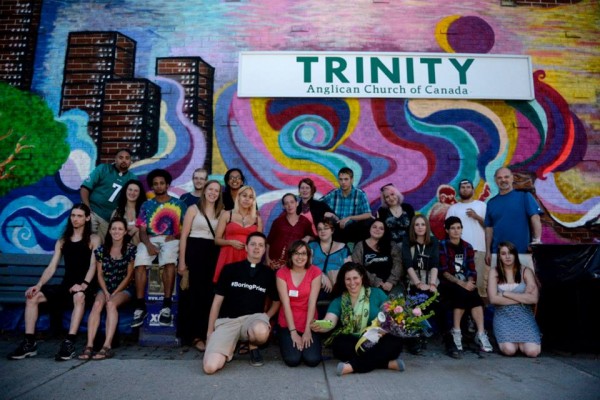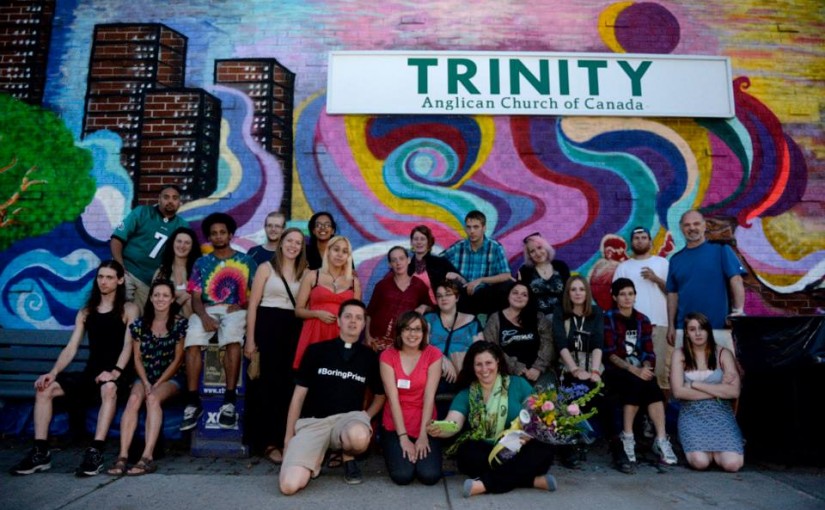
Nestled near the Rideau River in Ottawa, Trinity Anglican Church looks like many other urban churches—the city built up around its plain but charming exterior, arches and stained glass giving away its Christian roots. One of its inauspicious brick walls runs along a busy street. The length of the wall is punctuated only by a few benches and a bus stop.
For those with an imagination and a can of spray paint, this wall stands out as an impressive canvas. For some, this invites vandalism including tagging and hate speech. For others, like Trinity incumbent the Rev. Arran Thorpe, this same slate is a chance to showcase commitment to the Marks of Mission and to bring about renewal in the community.
Faced with the cost of graffiti removal multiple times a year, and often impaired by bitterly cold Ottawa winters, the community at Trinity pondered the purpose and meaning of their wall.
Thorpe notes that the challenges with the wall ran deeper than those brought up by a bit of spray paint. It turns out that the windowless wall was also a telling metaphor and barrier to living out the Marks of Mission. “You can’t look in to see what we’re doing, and we can’t look out to see you,” reflects Thorpe. “The church is not the wall . . . it is the people!”
Recalling a mural project out of a parish in Manchester, England focussing on kinship among Judaism, Islam, and Christianity, Thorpe wondered if urban art might be a way to forge a new relationship with Trinity’s brick wall. Instead of a barrier between church and community, and a target for vandalism, the wall could become something beautiful and transformative.
With enthusiastic momentum behind the mural vision, the parish turned to community partnerships to bring their vision to life. These included a grant from Ottawa Crime Prevention, and partnerships with Ottawa Innercity Ministries: Passion 4 Youth art program and House of PainT, a festival celebrating urban culture, including graffiti arts.
Through these community connections, Trinity worked with a team of marginalized youth with artistic gifts to conceive and commission their new wall. The artists were particularly taken by the style of the congregation’s stained glass. The flowing layers of colour and play with Christian symbols found in the windows are echoed in the wall design. The outdoor piece is also rooted in scenes from the community and inspires hope in its bright motifs and images of growth and renewal.
By August 2014, the small mural community was ready to set spray paint to wall. Twice weekly through the late summer the group convened and layer-upon-spray-paint-layer watched a metamorphosis happen. Gradually the same wall that was once a barrier to community became an invitation into it.
On any given evening, Thorpe is right there along with the youth in his clericals holding a can of spray paint. He enjoys the visual juxtaposition of a priest holding a vandal’s tool for the sake of art and community building. The strange sight, he says, challenge passers-by to think about “What is community? What is art? What is vandalism?”
The wall became a hub for a temporary, but strong, community. On Monday and Thursday evenings, as the youth paint away, women from the congregation supply home-cooked meals and eat with the youth, people stop to chat and even make donations to the church, and new friendships are forged.
Thorpe remarks that for some participating youth this is the first time they have been accepted without judgement by the church. “These kids are used to being spat on,” says Thorpe, but is heartened that at this wall reconciliation is taking place. “Our approach is to be in community, and talk about values, and be in relationship and explore how that might change people.” The wall, for one youth, is the first time she has had contact with the church in ten years.
On September 3, they celebrated the grand unveiling of the completed mural with a celebration that included friends and supporters from the parish and broader community, including Diocese of Ottawa Bishop John Chapman.
As the barriers between church and community dissolve through this project, Thorpe sees his parish at a crossroads. In this immediate post-mural time, Thorpe says they remain open to the movement of the Spirit. He is happy other businesses in the area are taking note of the anti-vandalism and community-building work that has happened at Trinity and hopeful that it will grow beyond their wall.
The small community that formed around this project also inspired reflection on Trinity’s vocation as a space for art and spirituality in the neighbourhood, including how their parish might be home to other art programs. Though these ideas are in the early stages, Trinity Anglican Church is open—as they were with their plain brick wall—to discerning together what God is revealing to the church in this local place.
“It is amazing what happens when you go outside your church walls,” Thorpe reflects “and discover that God is actively working outside of those walls and looking to the church to be a leader and bring people together.”
Interested in keeping up-to-date on news, opinion, events and resources from the Anglican Church of Canada? Sign up for our email alerts .

